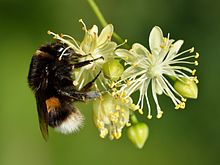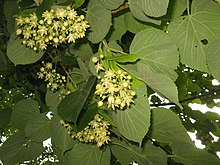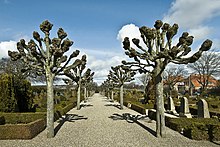Linden (genus)
| Linden trees | ||||||||||||
|---|---|---|---|---|---|---|---|---|---|---|---|---|

Silver linden ( Tilia tomentosa ) with autumn colors |
||||||||||||
| Systematics | ||||||||||||
|
||||||||||||
| Scientific name | ||||||||||||
| Tilia | ||||||||||||
| L. |
The lime ( Tilia ) over medium high German linden of althochdeutsch linta constitute a genus within the subfamily of tilioideae (Tilioideae) within the family of the Malvaceae (Malvaceae).
description
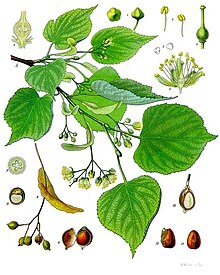
Vegetative characteristics
Linden species are deciduous trees . They do not form terminal buds, so their growth is sympodial . Depending on the type of linden tree, they reach a maximum height of between 15 meters (e.g. Crimean linden tree ) and 40 meters. The achievable trunk diameter also varies from species to species, usually between 1 and 1.8 meters. They can reach an age of up to 1000 years. The bud scales fall off early.
The alternate leaves are arranged in two rows and are divided into a petiole and a leaf blade. The simple leaf blade is usually heart-shaped.
Generative characteristics
In the lateral, zymous inflorescence there are three or more flowers. A conspicuous, elongated large bract is long fused with the inflorescence axis; it serves as a wing for the falling fruit cluster. The fragrant, hermaphrodite flowers are radial symmetry and five-fold with a double flower envelope . There are five sepals with nectar glands at their base. The five petals are white or yellow. There are many stamens present; they are free or grouped in five bundles. The stamens are often forked. Five carpels are a fünfkammerigen ovary grown together. There are two ovules in each ovary chamber . The stylus ends with a five-lobed scar. Linden species have a five-leaf ovary. There are closing fruits developed.
ecology
The linden species reproduce strongly vegetatively by stick rash and root spawn , but can also reproduce generatively .
With generative reproduction, pollination takes place by various insects, which are attracted by the intense scent of the linden blossom. These include bees and bumblebees, hoverflies and other dipteras . In some cases, however, there is also wind pollination . The seeds are mainly spread by the wind ( anemochory ).
Diseases and pests
Linden trees in particular, which grow as street trees in cities, are more frequently attacked by the linden spider mite . If the linden spider mite is heavily infested, the trees can be completely defoliated by July. Damage from the linden leaf wasp is also more common in street trees . The larvae of the great linden jewel beetle eat in and under the bark of well-sunlit areas of thick branches or the trunk of ailing linden trees. If the infestation is severe, the larvae can cause the branches to die off and break off and, as a result, the entire tree to die. The linden gall mite is often found on summer linden trees , but it is not counted among the pests.
Distribution and systematics
20 to 45 species (plus some (mainly naturally formed) hybrids ) of the genus Tilia thrive mainly in temperate to sub-tropical areas spread . 19 to 20 species occur in China , around 15 of them only there. In Switzerland, linden trees can form small but species-rich mixed forests. The identification of the species is difficult, molecular genetic data suggest that the number of species is probably around 22.


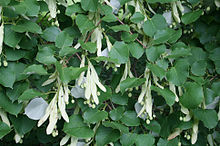

Depending on the author, there are 20 to 40 types (selection):
- American lime tree : ( Tilia americana L. ): native to the central , southern and eastern United States up to eastern Canada and south to Mexico; occasionally planted as a street or park tree in Central Europe
- Tilia amurensis Rupr. : It occurs in Korea , Russia and China.
- Tilia begoniifolia Steven : She is endemic to Iran .
- Tilia callidonta Hung T.Chang : It occurs in northwestern Yunnan .
- Tilia caroliniana Mill .: It occurs in the central and southeastern United States .; occasionally planted as a street or park treein Central Europe
- Chinese linden ( Tilia chinensis Maxim. ): It occurs in the Chinese provinces of Gansu, Henan, Hubei, Shaanxi, Sichuan, Xizang and Yunnan.
- Tilia chingiana Hu & WCCheng : It occurs in the Chinese provinces of Anhui, Jiangsu, Jiangxi and Zhejiang.
- Winter lime also stone lime ( Tilia cordata Mill. , Syn . : Tilia parvifolia Ehrh. , Tilia ulmifolia Scop. ): Native from Europe to Western Siberia and the Middle East
- Caucasian linden (also Black Sea lime) ( Tilia dasystyla Steven ): It occurs in two subspecies in the Caucasus region , in the Crimea and in Iran.
- Tilia endochrysea Hand .-- Mazz. : It occurs in the Chinese provinces of Anhui, Fujian, Guangdong, Guangxi, Hunan, Jiangxi and Zhejiang.
- Tilia henryana Szyszył. : It occurs in two varieties in the Chinese provinces of Anhui, Henan, Hubei, Hunan, Jiangsu, Jiangxi, Shaanxi and Zhejiang.
- Tilia heterophylla Vent. : Native to the northern and eastern United States.
- Tilia insularis Nakai : endemic to Korea
- Japanese linden ( Tilia japonica Simonk. & Miq. ): It occurs in Japan and in the Chinese provinces of Anhui, Jiangsu, Shandong and Zhejiang.
- Tilia jiaodongensis S.B. Liang : It occurs in the Chinese province of Shandong .
- Tilia kiusiana Makino & Shiras. : It occurs in Japan.
- Tilia kueichouensis Hu : It occurs in Chongqing Province, in northern Guizhou and maybe also in Yunnan .
- Tilia ledebourii Borbás
- Tilia likiangensis Hung T.Chang : It occurs in forests in northwestern Yunnan at altitudes around 2300 meters.
- Manchurian linden ( Tilia mandshurica Rupr. & Maxim. ): It occurs in four varieties in Japan, Korea, Siberia and China.
- Tilia maximowicziana Shiras. : endemic to Japan on the islands of Honshu and Hokkaido.
- Tilia membranacea Hung T.Chang : It occurs in the provinces of Hunan and Jiangxi .
- Miquel's lime tree ( Tilia miqueliana Maxim. ): Native to Japan and China.
- Mongolian linden ( Tilia mongolica Maxim. ): It occurs in the Chinese provinces of Hebei, Henan, western Liaoning, Nei Mongol and Shanxi.
- Tilia nobilis Rehder & EHWilson : It occurs in Sichuan and Yunnan and maybe also in Henan .
- Oliver's lime tree ( Tilia oliveri Szyszył. ): It occurs in two varieties in the provinces of Gansu, Hubei, Hunan, Shaanxi and Sichuan.
- Tilia paucicostata Maxim. : It occurs in three varieties in the provinces of Gansu, Hebei, Henan, Hubei, Hunan, Shaanxi, Sichuan and Yunnan at altitudes between 1,300 and 2,400 meters.
- Silver linden ( Tilia petiolaris DC. Syn .: Tilia tomentosa 'Petiolaris')
- Small -leaved linden ( Tilia platyphyllos Scop. ): Native to Central and Southern Europe , sometimes as far as the Caucasus and Asia Minor .
- Tilia rubra DC.
- Tilia sabetii Zare : It wasfirst describedfrom Iran in 2012. This endemic thrives only in the central Elburz region, south of Chaloos at altitudes of 900 to 1500 meters.
- Tilia stellato-pilosa Zare, Amini & Assadi : It wasfirst describedin 2012 from Iran . This endemic only thrives in the Dodangeh region70 to 80 km south of Sari only at altitudes above 1500 meters, especially 1750 to 1850 meters.
- Tilia taishanensis S.B.Liang : You only comes in the Chinese province of Shandong before.
- Tilia taquetii C.K. Schneid. : It occurs in Korea and China.
- Silver linden ( Tilia tomentosa Moench ): It is widespread from Southeastern Europe via Turkey to Syria .
- Tilia tuan Szyszył. : It occurs in three varieties in the Chinese provinces of Guangxi, Guizhou, Hubei, Hunan, Jiangsu, Jiangxi, Sichuan, Yunnan and Zhejiang at altitudes between 1200 and 2400 meters.


There are some hybrids, natural or by breeding :
- Crimean linden ( Tilia × euchlora K. Koch = Tilia cordata × Tilia dasystyla ); Hybrid created around 1860 - it is only known from culture.
- Dutch linden ( Tilia × europaea L. , Syn .: Tilia × intermedia Hayne , Tilia × vulgaris Hayne = natural hybrid of Tilia cordata (?) × Tilia platyphyllos )
- Imperial linden ( Tilia × europaea var. Pallida Rehder ) - Bred hybrid
- Moltke-Linde ( Tilia × moltkei Späth ) = Tilia americana × Tilia petiolaris - a hybrid created in Berlin around 1880
Central Europe
In the forests of Central Europe , only a few species of linden are native to the summer and winter linden and (on the south- eastern edge of Central Europe ) the silver linden. Nevertheless, these tree species play a not insignificant role both in local customs and in forestry .
use

Use of wood
Among the linden trees, the winter linden ( Tilia cordata ), the summer linden ( Tilia platyphyllos ) and the Dutch linden ( Tilia × europaea ), a cross between the first two, are used as a source of wood. The linden is one of the mature wood trees and has a light heartwood that does not differ in color from the sapwood . The wood is light colored, whitish to yellowish and often has a reddish or brownish tinge and has a dull sheen. It is more rarely striped or spotted with greenish tones.
Limewood is mainly used in sculpture , carving and turning work. For example, the use of limewood in German sculpture was widespread , especially in the late Gothic period , for example by Tilman Riemenschneider and Veit Stoss . But even in much later times limewood was preferred as a material by sculptors, such as Ludwig Schwanthaler . Since statues of saints were often made of linden wood, it was considered "lignum sacrum" ( Latin for "holy wood"). Today, however, the more easily obtainable wood of the Weymouths pine ( Pinus strobus ) is used for carving work. In Germany, the annual consumption of linden wood for carving work is estimated at 3000 to 5000 m³.
Furthermore, linden wood is used as blind wood and barrier veneer in furniture production, it is also suitable for imitating walnut wood. Front sections of cuckoo clocks, drawing and drawing boards, hat shapes and wooden heads as models for wig-makers are often made of limewood. It is used to manufacture foundry models, toys, kitchen utensils and wooden slippers. Linden wood is also used to make barrels and containers for dry and odor-sensitive goods, to make cheap pencils and matches. In musical instrument making, it is used to manufacture harps, as a keyboard for pianos, as a body for guitars and as reed pipes for organs. Linden wood is also used to make drawing and filter charcoal. In the past, coal from linden wood was also used to produce black powder and as a dental care product.
Further use
Linde during flowering as is by beekeepers honey bees particularly appreciated because the bees from the nectar of considerable amounts of lime blossom the linden honey can produce. Linden blossom honey has the typical linden aroma, is light yellow to greenish-yellow in color, freshly liquid and crystallizes flaky or grainy over time. Dried lime blossom result in a medicinal tea , which has a calming effect on the nerves. It helps with colds with its sweaty and cough- relieving effect.
Before the introduction of linen and hemp (probably until late antiquity ), the fibers of the soft linden wood - the bast - were used in Central Europe to make ropes, mats, bags and clothing. Linden bast was obtained from young linden trees (also called baest) in May by peeling off the bark, separating the soft inner side and placing it in the water until the bast came off, which was then dried in the sun.
Cultural history

With the Teutons and the Slavs the linden was considered a sacred tree. Whether the Teutons actually ascribed the linden tree to the goddess Freya , as is often claimed, is not clearly proven. Unlike the English oak , she was considered a female being.
Many places in Central Europe used to have their village linden, which formed the center of the place and was a meeting point for exchanging news and bridal gazes. At the beginning of May, dance festivals were mostly celebrated under this tree - sometimes on so-called dance linden trees . In addition, the village court was usually held here, a tradition that goes back to the Germanic court assembly, the Thing . The linden tree is therefore also known as the " court tree " or " court linden tree ".
After wars (or plague epidemics ) there was the custom of planting so-called peace linden trees. Most of the surviving specimens are reminiscent of the Franco-Prussian War of 1870/71, but some also of the Peace of Westphalia , such as the "Friedenslinde am Dreierhäuschen" in Ponitz , Thuringia , or of local warlike events such as the destruction of Ratzeburg .
About 850 places or districts in Germany have names that can be traced back to the linden tree. The name of the city of Leipzig, for example, is derived from the Sorbian word Lipsk and means Linden-Ort.
The town of Neuenstadt am Kocher in Baden-Württemberg was formerly known as Neuenstadt an der Linde. There was an ancient summer linden tree at the city gate. For centuries, its low side branches were supported by 100 columns, most of them made of stone. The oldest mention comes from the year 1448. In 1865 it had a circumference of 985 centimeters. Its last remains were destroyed along with the city in 1945.
The linden tree and especially its leaf is the symbol of the Sorbian people. In the Czech Republic , too , the linden tree ( Czech lípa ) is a national symbol tree, numerous place names are derived from it (e.g. Česká Lípa (Bohemian Leipa), Lipno reservoir , Lipnice, Lipník, Lípová). In Croatia , the lipa 'linden tree' is part of the legal currency as a sub-unit of the kuna .
Linden leaf tea ( Ihlamur Çayı ) is a very popular herbal tea in Turkey and is used in Turkish culture to treat ailments of all kinds.
Also in a Latin tongue twister ( Filia sub tilia nectit subtilia fila ) 'the daughter ties fine threads under the linden tree'.
Wilhelm Müller set a literary monument to the tree in his poem Der Lindenbaum . The setting of the poem by Franz Schubert became a musical arrangement by Friedrich Silcher for the folk song Am Brunnen vor dem Tore .
The song Dragostea din tei by the Moldovan pop group O-Zone sings about “love in the linden tree”.
Since 2014, the Lindenbaum Museum in Neudrossenfeld has been using models to show over 40 examples of guided linden trees in Europe, many of them dance linden trees.
Well-known single specimens of the genus Linden
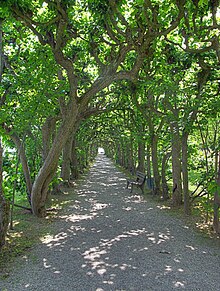


Striking and old trees in Central Europe are mostly winter or summer linden trees .
Winter linden
Well-known single trees / avenues of the winter linden ( Tilia cordata ) are:
- Ganghofer Allee in Welden
- Kunigundenlinde near Kasberg (near Graefenberg)
- Tassilolinde near Wessobrunn Monastery , Bavaria
- Forster Linde in the Forst district of Aachen
- Thick linden tree in the Upstedt district of Bockenem
The largest closed linden forest in Europe is the Colbitzer Lindenwald in Saxony-Anhalt ; the linden tree population consists of winter linden trees.
Summer linden trees
Well-known specimens / avenues of the summer linden tree ( Tilia platyphyllos ) are:
- Tanzlinde in Effeltrich
- Hindenburglinde in Ramsau near Berchtesgaden
- Summer linden tree on the Kirchsteig, Dießen
- Röth-Linde in Munich
- The Linner linden tree near Linn (Switzerland) is one of the largest trees in Switzerland with a height of 25 meters and a trunk circumference of 11 meters. It was planted around 500 to 600 years ago to commemorate the victims of the plague epidemics; the exact date is not known.
- Linden tree in Schenklengsfeld (probably the oldest tree in Germany)
- Schmorsdorfer Linde in Schmorsdorf bei Maxen, Müglitztal municipality, Saxony
- Wolfram linden tree in Ried
- Kaiser-Lothar-Linde in Königslutter
- Summer linden tree in Geisenheim , Rheingau
- Kaditzer Linde in Dresden - Kaditz
- Schluttenbacher Linde
- Giant linden tree in Heede , Emsland
More types
The linden tree planted in 1991 in the Thuringian town of Niederdorla - the new topographical center of Germany as a whole - is an imperial linden tree , i.e. a cultivated form of the Dutch linden tree ( Tilia × europaea 'Pallida').
Distinctive single trees without assignment to a species
- Annalinde , Baden-Württemberg
- Old Lime Tree (Eschelbronn) , Baden-Wuerttemberg
- Alte Linde (Schwabach) , Bavaria
- Old brick linden tree , Gönningen, Baden-Wuerttemberg
- Petition linden tree , Potsdam
- Court linden tree in Collm
- Hochmössinger Dorflinde in Oberndorf am Neckar , Baden-Wuerttemberg
- Hollow lime tree in Obermarbach , Bavaria
- Katharinenlinde , Esslingen am Neckar , Baden-Wuerttemberg
- Upper linden tree on the upper valley meadow , Hildrizhausen , Baden-Wuerttemberg
- Linden tree at the court square of Vollmarshausen , Lohfelden, Hesse. Medieval court
- Reinberger Linde in Reinberg , Mecklenburg-Western Pomerania
- Sinziger Linde , Rhineland-Palatinate
- Millennial linden tree in Elbrinxen, City of Lügde, North Rhine-Westphalia
- millennial linden tree in Schenklengsfeld , Hesse
- millennial linden tree in Grottenthal near Neukirchen-Balbini , Bavaria
- Millennial linden tree in the Polchow cemetery in Mecklenburg-Western Pomerania
- Türkenlinde (Markt Piesting) , Lower Austria
- Turkish linden tree from Ottendorf , a pair of linden trees in the district of Ottendorf
- Zundelbacher Linde near Weingarten , Baden-Württemberg
More than 300 years old linden trees line the ascent to Antoniberg in Stepperg
Linn lime tree (Switzerland)
250-year-old imperial linden tree on the castle grounds Schloss Burg in Solingen
200 year old Hunger linde in Langenbeutingen
Lindenallee, church square Weissenbach an der Triesting
Linden allegedly from the year 937 in Schluttenbach , Northern Black Forest
Millennial Feme lime tree in Rumscheid, Hagen- Dahl
Götzener Linde ( natural monument )
Linden tree in Munzenberg Castle
Linden tree with multiple stick movements / Vogelsberg
literature
- CD Pigott: A review of chromosome numbers in the genus Tilia (Tiliaceae). In: Edinburgh journal of botany. Volume 59, 2002, ISSN 0960-4286 , pp. 239-246, doi: 10.1017 / S0960428602000057 .
- Ya Tang, Michael G. Gilbert, Laurence J. Dorr: Tiliaceae. In: Wu Zheng-yi, Peter H. Raven, Deyuan Hong (Eds.): Flora of China. Volume 12: Hippocastanaceae through Theaceae. Science Press and Missouri Botanical Garden Press, Beijing and St. Louis 2007, ISBN 978-1-930723-64-1 , p. 246 ( Tilia. Text same online as printed work, efloras.org ).
- Habib Zare, T. Amini, Mostafa Assadi: A review of the genus Tilia L. (Tiliaceae) in Iran, new records and new species. In: Iran. J. Bot. Volume 18, Issue 2, 2012, pp. 175-190.
- Klaus Popko, Bernd Reuter: On the cultural-historical significance of the linden tree. In: Sachsen-Anhalt-Journal. 26 (2016), no . 2, ISSN 0940-7960 , p. 27 f. ( journal.lhbsa.de ).
Web links
- Winter linden (Tilia cordata) at baumkunde.de
- Summer lime tree (Tilia platyphyllos) at baumkunde.de (tree identification)
- Lindenbaum Museum in Neudrossenfeld
Individual evidence
- ↑ Linden Nature Lexicon. In: natur-lexikon.com, accessed on November 21, 2010.
- ↑ Heinz Ellenberg: Vegetation of Central Europe with the Alps (= basics of the vegetation structure in causal, dynamic and historical view. Part 2). Ulmer, Stuttgart 1963, DNB 451093747 , p. 255.
- ↑ a b c d e f Habib Zare, T. Amini, Mostafa Assadi: A review of the genus Tilia L. (Tiliaceae) in Iran, new records and new species. In: Iran. J. Bot. , Volume 18, Issue 2, 2012, pp. 175-190.
- ↑ a b c d e f g h Tilia in the Germplasm Resources Information Network (GRIN), USDA , ARS , National Genetic Resources Program. National Germplasm Resources Laboratory, Beltsville, Maryland. Retrieved June 18, 2017.
- ↑ a b c d e f g h i j k l m n o p q r s Ya Tang, Michael G. Gilbert & Laurence J. Dorr: Tiliaceae. - Same text online as the printed work , In: Wu Zheng-yi, Peter H. Raven, Deyuan Hong (Ed.): Flora of China. Volume 12: Tiliaceae.
- ↑ a b c Walter Erhardt , Erich Götz, Nils Bödeker, Siegmund Seybold: The great pikeperch. Encyclopedia of Plant Names. Volume 2. Types and varieties. Eugen Ulmer, Stuttgart (Hohenheim) 2008, ISBN 978-3-8001-5406-7 .
- ↑ a b c d D. Grosser, W. Teetz: Linde . In: Arbeitsgemeinschaft Holz e. V. (Ed.): Local timber (loose-leaf collection) . No. 17 . Information service wood, wood sales fund - sales promotion fund of the German forest and wood industry, 1998, ISSN 0446-2114 .
- ↑ a b Doris Laudert: Myth Tree: History, Customs . 40 tree portraits from maple to lemon. 7th, revised edition. blv, Munich 2009, ISBN 978-3-8354-0557-8 , p. 169 .
- ↑ Josef Lipp u. a .: Handbook of Apiculture - The Honey. 3., rework. Edition. Ulmer, Stuttgart 1994, ISBN 3-8001-7417-0 , p. 18.
- ↑ Alexander Demandt: Above all tops. The tree in cultural history . Albatros, Düsseldorf 2005, ISBN 3-491-96140-8 , p. 86 .
- ↑ Rainer Graefe: Buildings from living trees. Guided dance and court linden trees . Ed .: Anke Naujokat (= worksheets on building history . Volume 4 ). Geymüller, Publishing House for Architecture, Aachen [u. a.] 2014, ISBN 978-3-943164-08-4 (exhibition catalog).
- ↑ Jean-Denis Godet: Godet nature guide. Trees and shrubs. Ulmer, Stuttgart 2007, ISBN 3-8001-5354-8 .
- ↑ Otto Feucht: Swabian tree book. Edited by the Royal Württemberg Forest Directorate. Plug & Schröder, Stuttgart 1911, OCLC 611161490 , pp. 20-23, table 8.

